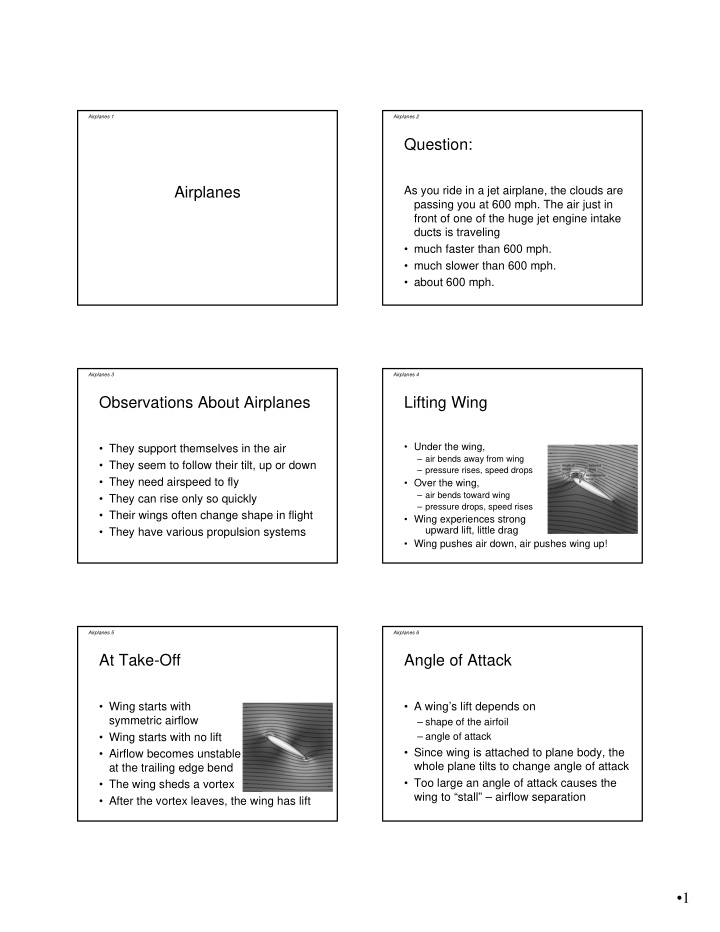



Airplanes 1 Airplanes 2 Question: Airplanes As you ride in a jet airplane, the clouds are passing you at 600 mph. The air just in front of one of the huge jet engine intake ducts is traveling • much faster than 600 mph. • much slower than 600 mph. • about 600 mph. Airplanes 3 Airplanes 4 Observations About Airplanes Lifting Wing • Under the wing, • They support themselves in the air – air bends away from wing • They seem to follow their tilt, up or down – pressure rises, speed drops • They need airspeed to fly • Over the wing, – air bends toward wing • They can rise only so quickly – pressure drops, speed rises • Their wings often change shape in flight • Wing experiences strong upward lift, little drag • They have various propulsion systems • Wing pushes air down, air pushes wing up! Airplanes 5 Airplanes 6 At Take-Off Angle of Attack • Wing starts with • A wing’s lift depends on symmetric airflow – shape of the airfoil • Wing starts with no lift – angle of attack • Since wing is attached to plane body, the • Airflow becomes unstable whole plane tilts to change angle of attack at the trailing edge bend • Too large an angle of attack causes the • The wing sheds a vortex wing to “stall” – airflow separation • After the vortex leaves, the wing has lift •1
Airplanes 7 Airplanes 8 Stalled Wing Wing Shape • Upper boundary layer • Asymmetric airfoils produce large lifts stops heading forward – well suited to low-speed flight • Upper airstream detaches • Symmetric airfoils produce small lifts from wing’s top surface – well suited to high-speed flight • Lift is reduced – can fly inverted easily • High-speed planes often • Pressure drag appears change wing shape in flight • Wing can’t support plane Airplanes 9 Airplanes 10 Orientation Control Propellers • Three orientation controls: • Propellers are spinning wings – Angle of attack controlled by elevators – They deflect air backward – Left-right tilt controlled by ailerons – Do work on air (add energy) – Left-right rotation controlled by rudder – Pump air toward rear of plane • Steering involves ailerons and rudder • Action-Reaction • Elevation involves elevators and engine – They push the air backward – Air pushes them forward Airplanes 11 Airplanes 12 Jet Engines, Part 1 Jet Engines, Part 2 • Jet engines pump air toward rear of plane • Air entering diffuser slows and pressure rises • Compressor does work on air – Engine consists of an oval “ball” with a complicated duct or passageway through it • Fuel is added to air and that mixture is burned – Air inside the duct exchanges pressure and • Expanding exhaust gas does work on turbine speed repeatedly • As exhaust leaves – Engine adds nozzle it speeds up energy to air and pressure drops inside the duct •2
Airplanes 13 Airplanes 14 Jet Engines, Part 3 Question: • Turbojet moves too little air and changes As you ride in a jet airplane, the clouds are that air’s speed too much passing you at 600 mph. The air just in front of one of the huge jet engine intake • Too much energy ducts is traveling • Too little momentum 1. much faster than 600 mph. • Turbofan moves 2. much slower than 600 mph. more air and gives it less energy 3. about 600 mph. Airplanes 15 Summary About Airplanes • Airplanes use lift to support themselves • Propulsion overcomes induced drag • Speed and angle of attack affect altitude • Extreme angle of attack causes stalling • Propellers do work on passing airstream • Jet engines do work on slowed airstream •3
Recommend
More recommend